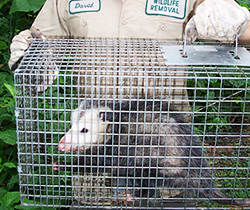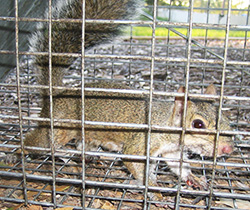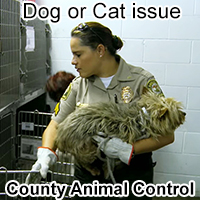- bouldercity@aaanimalcontrol.com
Call 24/7 for a free quote:
702-577-2880
Boulder City Wildlife Control / Nevada Animal Removal
Professional Wildlife Services - Animal Pest Control in Boulder City, NV. Call us: 702-577-2880

- Noises in Your Attic?
- Unwanted Wildlife?
- Bird or Bat Problem?
- Rodent Infestation?
- We Can Solve It!
Please, no calls about DOG or CAT problems. Call animal services: 702-293-9283.

 Professional Wildlife Services provides professional wildlife control for both residential & commercial customers in the
city of Boulder City in Nevada. We offer custom animal control solutions for almost any type of wildlife problem, whether
it be the noises of squirrels running through the attic, a colony of bats living in a building, animals digging in your yard, or
the destructive behavior of a raccoon or other critter, we have the experience and the tools to quickly and professionally
solve your problem. For a consultation and price quote, give us a call at 702-577-2880
Professional Wildlife Services provides professional wildlife control for both residential & commercial customers in the
city of Boulder City in Nevada. We offer custom animal control solutions for almost any type of wildlife problem, whether
it be the noises of squirrels running through the attic, a colony of bats living in a building, animals digging in your yard, or
the destructive behavior of a raccoon or other critter, we have the experience and the tools to quickly and professionally
solve your problem. For a consultation and price quote, give us a call at 702-577-2880
Click here to check our prices updated for year 2025. There are many Boulder City pest control companies for animals out there, but not all of them are licensed and insured professionals. Make sure that you hire a competent expert for your Boulder City exterminator of wildlife. At Professional Wildlife Services, we will be courteous and friendly and take the time to answer your questions. Give our Boulder City trappers at Professional Wildlife Services a call, and we will listen to your problem, and make an appointment to perform an inspection. Feel free to email us at bouldercity@aaanimalcontrol.com
 Resources for free wildlife removal in Boulder City
Resources for free wildlife removal in Boulder City
If you can't afford our pro wildlife work, you can try these agencies for free wildlife removal:
Clark County Animal Services: 702-293-9283
Nevada Wildlife Commission: 702-486-5127
Boulder City Police Department: 702-293-9224
These agencies will only help with certain types of wildlife problems, and they are not always consistent. If you want a high quality of
help done right, call our company.
 Nevada is full of wildlife, including snakes, squirrels, raccoons, skunks, opossums, and more. Wildlife removal is a complex field. I
recommend professional Boulder City wildlife control services if you want to solve a critter problem legally and correctly. For example, we specialize in animals in the attic, which have broken into the house
and almost always have a nest of baby animals. It is necessary to perform correct
preventative repairs to keep pest animals a out of your house for good. We perform full building inspection, do the
the repairs and we also offer attic decontamination if necessary. Rats and mice love to live in attics, and can chew wires or leave droppings. Some Boulder City animals
frequently enter homes, and correct removal is not a simple task.
Nevada is full of wildlife, including snakes, squirrels, raccoons, skunks, opossums, and more. Wildlife removal is a complex field. I
recommend professional Boulder City wildlife control services if you want to solve a critter problem legally and correctly. For example, we specialize in animals in the attic, which have broken into the house
and almost always have a nest of baby animals. It is necessary to perform correct
preventative repairs to keep pest animals a out of your house for good. We perform full building inspection, do the
the repairs and we also offer attic decontamination if necessary. Rats and mice love to live in attics, and can chew wires or leave droppings. Some Boulder City animals
frequently enter homes, and correct removal is not a simple task.
 DOG or CAT: If you need assistance with a domestic animal, such as a dog or a cat, you need to call your local
Clark County Animal Control
for assistance. They can help you out with issues such as stray dogs, stray cats, vaccinations, licenses,
pet adoption, lost pets, and more. If you have a wildlife problem, you can try calling the Clark County animal control, and see what they have to
say, but they will certainly not help you with a complex wildlife problem such as critters in your attic. They are a free government agency that
helps with dog and cat issues only.
DOG or CAT: If you need assistance with a domestic animal, such as a dog or a cat, you need to call your local
Clark County Animal Control
for assistance. They can help you out with issues such as stray dogs, stray cats, vaccinations, licenses,
pet adoption, lost pets, and more. If you have a wildlife problem, you can try calling the Clark County animal control, and see what they have to
say, but they will certainly not help you with a complex wildlife problem such as critters in your attic. They are a free government agency that
helps with dog and cat issues only.
Clark County Animal Services: 702-293-9283
Boulder City Wildlife Tip:
When raccoon prevention methods prove insufficient and these resourceful animals become a nuisance, trapping might seem like a viable solution. However, it's crucial to approach raccoon trapping responsibly and humanely, while also being aware of local regulations regarding wildlife trapping and relocation. This article provides an overview of raccoon trapping techniques, discussing trap types, bait selection, and effective methods.
Understanding Local Regulations
Before setting any traps, it is imperative to check with your local animal control, wildlife agencies, or homeowner's association about the legality of trapping and relocating raccoons in your area. Some regions may require permits, specify allowable trap types, or restrict relocation practices. Understanding these regulations will ensure you are operating within the law and avoiding potential penalties.
Choosing the Right Trap Type
The most common and humane type of trap for raccoons is a live cage trap. These traps are designed to capture the animal without causing serious injury. They typically feature a trigger mechanism that closes a door when the raccoon enters the cage to reach the bait.
- Single-Door Traps: These traps have one entry point and are suitable for general trapping.
- Double-Door Traps: With doors at both ends, these traps can be more appealing to raccoons as they offer a perceived escape route, often leading to quicker entry.
- Trap Size: Select a trap that is appropriately sized for a raccoon, typically around 32-40 inches long, 10-12 inches wide, and 12-15 inches high. A trap that is too small will be inhumane, while one that is too large may not trigger effectively.
Selecting Effective Bait
Raccoons are omnivores with a sweet tooth, making sweet and fatty foods effective baits. However, their opportunistic nature means they can be attracted to various items.
- Sweet Baits: Marshmallows, grapes, peanut butter (on crackers or bread), and fruit (like apples or melon) are often highly effective.
- Fatty Baits: Canned sardines or tuna (punctured to release the scent), bacon, or even dry cat food can also be appealing.
- Placement: Place the bait at the very back of the trap to encourage the raccoon to fully enter and trigger the mechanism.
Setting the Trap Effectively
Proper trap placement and setup are crucial for successful and humane capture.
- Location: Identify areas where you have observed raccoon activity, such as near garbage cans, gardens, or entry points to your home. Place the trap on a level surface in a shaded or sheltered area to protect the captured animal from the elements.
- Preparation: Secure the trap doors in the open position according to the manufacturer's instructions. Ensure the trigger mechanism is sensitive but not so light that it will be set off by wind or other disturbances.
- Camouflage (Optional): While not always necessary, you can lightly camouflage the trap with natural materials like leaves or twigs to make it appear less threatening. Avoid obstructing the trap doors or trigger mechanism.
- Scent Masking: Wear gloves when handling the trap and bait to minimize leaving your scent, which could deter raccoons.
Monitoring the Trap and Handling Capture
Once the trap is set, it is essential to check it frequently, ideally at least twice a day. This minimizes the amount of time an animal spends confined.
- Humane Handling: If you capture a raccoon (or any other animal), approach the trap calmly and cautiously. Avoid making loud noises or sudden movements that could stress the animal.
- Relocation (If Permitted): If local regulations allow relocation and you intend to do so, transport the trapped raccoon in the covered trap to a suitable release location at least 5-10 miles away from your property in a similar habitat. Avoid direct contact with the animal.
- Alternative Solutions: Consider contacting your local animal control or a wildlife removal professional to handle the trapping and relocation process, especially if you are uncomfortable doing so yourself.
Important Considerations
- Non-Target Animals: Be aware that you may unintentionally trap other animals. Check the trap frequently and release any non-target species immediately and unharmed.
- Mother Raccoons and Kits: During spring and summer, be cautious about trapping a mother raccoon, as she may have dependent young nearby. Trapping and relocating the mother will likely lead to the starvation of her kits. If you suspect a mother and her young are present, consider waiting until the young are mobile before attempting to trap.
- Long-Term Solutions: Remember that trapping is often a temporary solution. Addressing the underlying reasons why raccoons are attracted to your property (food sources, access to shelter) is crucial for long-term prevention.
Trapping raccoons requires careful planning, adherence to local regulations, and a commitment to humane practices. By understanding the appropriate trap types, effective bait, and proper methods, you can increase your chances of safely and successfully removing unwanted raccoons from your property. However, always prioritize prevention and consider seeking professional assistance when needed.
Boulder City, NV Animal Control News Clip:
No current news article at this time.
We are Boulder City wildlife management experts, and are familiar with all the pest animals, including all species of Nevada snakes and
bats. We at Professional Wildlife Services are the best among Boulder City nuisance wildlife companies and can solve all animal damage issues. Our wildlife operators are skilled at bird control and
bat removal, and would be happy to serve your Boulder City bat control or pigeon and bird control needs with a professional solution. Opossums, skunks, moles, and other animals
that can damage your lawn - we are the exterminators who can capture and remove them. Our specialty is removal of animals in homes such as raccoons in the attic or squirrels in the attic.
Our professional pest management of wildlife and animals can solve all of your Boulder City
critter capture and control needs. Give us a call at 702-577-2880 for a price quote and more information.
If you have any questions about a wildlife problem in Boulder City, or wildlife removal in Clark County, please give Professional Wildlife Services a call at 702-577-2880, and we will listen to your problem, give you a price quote, and
schedule an appointment, usually same day or next day, to solve the problem.


















